The Sky Above, the Earth Below

 On clear nights, Venus sparkles in the indigo sky. She’s been a bright evening star since early October. In late November and early December when she’s highest in the sky, I’ll stand at the windows on clear cold nights and soak in Her beauty. I’ll scan the southern sky for glowing Jupiter and pale Saturn traveling in the same planetary arc, quietly cycling above Earth’s chaos and confusion.
On clear nights, Venus sparkles in the indigo sky. She’s been a bright evening star since early October. In late November and early December when she’s highest in the sky, I’ll stand at the windows on clear cold nights and soak in Her beauty. I’ll scan the southern sky for glowing Jupiter and pale Saturn traveling in the same planetary arc, quietly cycling above Earth’s chaos and confusion.
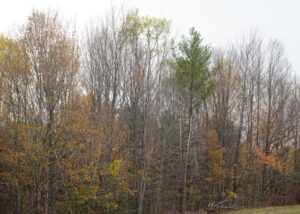
In my earthly home, the ground is saturated from months of rain. Crumpled maple leaves fall brown and blighted, replacing the usual autumn reds. Next year’s maples may recover, but climate crisis feels close after a summer of fire, flood, and infestation.
The giant oaks grew small new leaves after gypsy moth caterpillars stripped them bare in June. New leaves promise survival for the trees, but oaks can’t replace the acorns with a second crop.
What will the wild turkeys eat this winter? How will squirrels, rabbits, and red fox survive? And the blue jays and deer? Emaciated does will abort their pregnancies and reabsorb fetuses to survive. It’s a wise plan, but a desperate maneuver by nature. Some deer won’t make it, but the strong will get by on stored summer fat, tree buds, hickory nuts, and grasses unless there’s a deep snow pack.
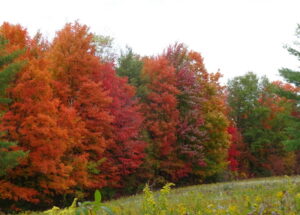
Earth’s inhabitants teeter between life and death while I hang on to hope we’ll wake up and save our planetary home.
In late December, Venus will drop beneath the horizon and by January, she’ll be an eastern morning star rising while I sleep. Jupiter and Saturn will become morning lights, too. Even though I won’t see them over the forested hill east of my home, I love knowing they’ll be there.
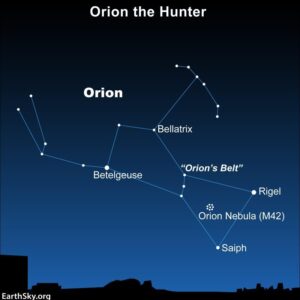
When I look out my bedroom window at 4 am in early October, the constellation Orion beams in the southern sky with His bright stars Betelgeuse and Rigel. I remember Vic’s admiring voice saying, “Dig the belt.” We loved watching Orion each winter. East of Orion, Sirius is the brightest star in the night, associated with the Egyptian god Osiris and the yearly flooding of the Nile. Separated and quarrelsome as humans are on this earth, we admire the same constellations, planets, and stars.
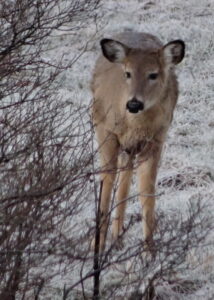 The deer will live or starve depending on the winter cold. The unborn fawn may die to keep its mother alive. Next year’s autumn leaves may be drab or maples may be red and oaks loaded with acorns.
The deer will live or starve depending on the winter cold. The unborn fawn may die to keep its mother alive. Next year’s autumn leaves may be drab or maples may be red and oaks loaded with acorns.
Still, no matter what we confused humans do, we can count on the heavenly rounds. As the climate goes mad and life struggles to survive, I look up on clear autumn and winter nights, comforted as the Moon, stars, constellations, and planets watch over me.
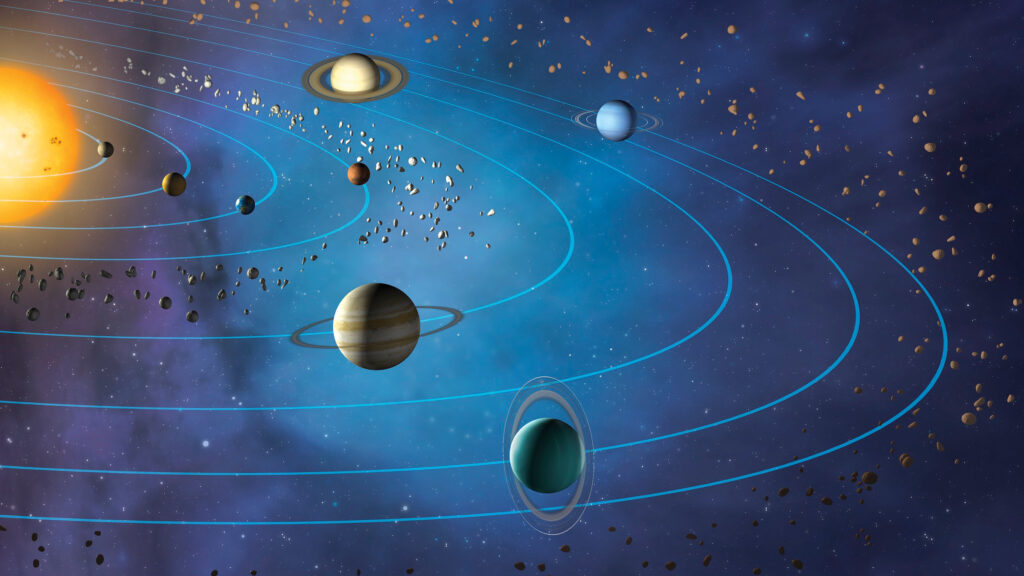
***
My husband Vic was an astrophysicist, so maybe I caught the night sky bug from him, but more likely it’s because I live far from light-filled cities and have large windows to the south and west with year round views of dark night skies. I turn down the lights in my house, watch the sky, and feel my place (and insignificance) in the cosmic rounds. Can you see the night sky where you live? How does it make you feel? Do you know any of the constellations by name? For other posts about nature see Transformation: The Season Is Changing and So Are We or Healed by Nature, Inspired by Love.


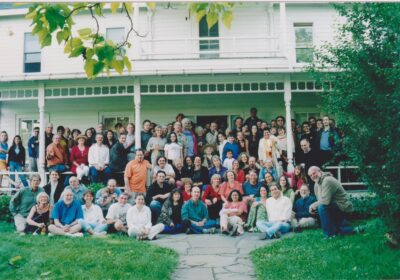
November 23, 2021 at 11:46 am
anne
I just got an iPhone and now I am excited that soon I will have this app on my phone.
May you have a joyful Thanksgiving as well, Elaine!
November 23, 2021 at 3:26 pm
Elaine Mansfield
I don’t know if SkyGuide is the best, but my son has a company called Mansfield Computer Solutions and it’s what he recommended. I like it other than the “ethereal” music when I look at the constellations on the maps, so I turn down the sound. Easy!
November 22, 2021 at 11:15 am
anne
Dear Elaine,
As your friend Dennis wrote, “How beautiful! It is written like some glorious poem.” I think one of the reasons I wait to respond to your posts is that it’s a treat to also read what your followers write and makes me feel a part of your online community.
We often don’t have many clear skies during November (we’ve had 14 inches of rainfall so far this month!), but it’s always a celebration of the stars when we do. Watching Orion stride across the night sky never ceases to feel magical as well as comforting. And now I will think of Vic saying ““Dig the belt.”
The book we discovered for identifying the stars (since we had no astrophysicist living with us) is “The Stars” by H.A. Rey (the author of the Curious George books). We use our cookbook holder more for viewing the current star chart than we do for cooking. Perhaps his talent illustrating children’s books made his pictures of the constellations so easy to pick out. Our copy is completely falling apart from all the nights we used it lying on blankets on clear nights looking up at the night sky.
Sending love your way, Anne
November 22, 2021 at 6:29 pm
Elaine Mansfield
I’ve known my friend Dennis for 40 years. That’s the thing about my community. A group of us studied philosophy and more with the same teacher in the 1970s and we’re still connected. Many still live here–like Dennis and like me. Others moved, but some of them are rejoining classes via Zoom.
The sky is clear and I see Venus and Jupiter. Later, I may be able to “Dig the Belt.” We read Curious George to our sons. I didn’t know he wrote a book called ‘The Stars.’ I use SkyGuide, an app on my iphone. Once upon a time, I didn’t think I needed a cell phone, but when my son showed me SkyGuide or the equivalent on his cell phone and named the stars for me, I was convinced. Now I need an iphone for both my hearing aid (R ear) and cochlear implant (L ear). All the settings are on the iphone. Crazy electronic world, but I love the ease of finding and naming the stars, planets, and constellations. Have a joyful Thanksgiving, Anne. Blessed Be!
November 15, 2021 at 4:27 am
Aladin Fazel
How beautiful you’ve figured out these images of Mother Nature. Thank you, dear Elaine. It makes me jealous to see what you can observe from your window! We live near the forest though, when I look through the window, I see houses and trees, and if I am lucky to have a clear sky, I can see some stars. Anyway, the winter is coming, and we will be wintering this like the ones before, and the deers, I am sure, will survive as nature knows well how. Stay safe and be cosy and well.
November 15, 2021 at 10:33 am
Elaine Mansfield
I’m grateful for my clear views of the sky and hills. We made a choice to mow the fields once a year to keep the views, but this also meant good habitat for wildflowers, butterflies, and birds. Most of the land is still forest, but the house is surrounded by fields on 3 sides. Yesterday, I walked with a friend who showed me all the trees where bucks scraped their antlers on the bark. They kill some small trees this way, but it’s nice to know who lives here. When there’s snow, I see many tracks. I spend time in the forest year round, wearing warm clothing for snow this time of year. The dogs and I need exercise and fresh air, and it’s always beautiful even in the worst weather.
November 14, 2021 at 8:43 pm
Mark Liebenow
I turn down the lights and watch the sky. Such simple presence to eternity. Beautiful post, Elaine!
November 15, 2021 at 10:24 am
Elaine Mansfield
Thank you, Mark. I’m grateful to live in a dark sky area so I can see the stars when the sky clears. Clouds are the winter norm here and last night we had our first snow. Only an inch, so just the beginning of what’s to come.
November 14, 2021 at 7:42 pm
Dennis Dore
How beautiful! It is written like some glorious poem.
November 15, 2021 at 10:22 am
Elaine Mansfield
Thank you, Dennis. It felt like that. The night sky lifts me up.
November 11, 2021 at 5:32 pm
Jean Raffa
Thank you for your beautiful images and reminders about the wonders of our world and universe. We all have times when we get so caught up in the microcosms of our lives that it’s easy to forget the big picture. Stars make it easier to remember.
November 11, 2021 at 5:54 pm
Elaine Mansfield
The night skies are a gift of rural living with no strong lights for miles. It’s been a challenging time in political realms and for people close to me, but when I look up at stars in a clear sky, all is well. I especially love those 3 am meditations on Orion and Sirius. They’ll hang around all winter.
November 10, 2021 at 2:34 pm
Marian Beaman
Beautiful post, Elaine. I live in a light-filled city, but I still walk outside to look at the heavens when the sky has turned to indigo. Then I spy Venus, a star I remember Aunt Ruthie pointing out to me. She also helped me spot Orion and Cassiopeia spelled out as a “W” in the night sky. In college, I took an astronomy course but was too starry-eyed to remember much. Later, I dated the instructor, a cold fish, as I recall.
I knew Vic had a doctorate but didn’t know (or remember) he was an astrophysicist. Apparently he is/was not a cold fish!
November 10, 2021 at 9:19 pm
Elaine Mansfield
Venus, Jupiter, and the Moon are so bright now, you must be able to see them in the city. I love how Aunt Ruthie slides into her gentle teacherly role, showing you Venus and two memorable constellations. Cassiopeia is on the north side of my house, but I have to walk to the driveway to see it. Willow and I walk there together before sleep. I look up if the sky is clear, but her nose is always on the ground. I never took an astronomy course, but the summer before Vic taught his first astronomy lab at Colgate (1973?), we spread blankets on the ground on warm nights and looked up at the stars using Vic’s star map. Believe me, computer Sky Guides are much easier, but we had fun finding and naming what we saw. As an astrophysicist, Vic focused on abstract areas like the origins of the cosmos and quantum mechanics and learned to write about these things in compelling ways. He was an interesting mix of Philosophic Theorist and Italian peasant, both at the same time. No one ever called him cold. 😉
November 10, 2021 at 3:57 am
susan scott
I’m writing this while my husband is driving, on my phone. We’re on our way to Johannesburg. Last night we stayed at a very way out of the way ‘homestead’ but it would take too long to explain how and why. Totally off the beaten track – we’ve never stayed there before. We were woken at 2 am with frantic barking dogs in the neighbourhood so we went out to investigate. The Milky Way was truly magnificent. There’s something about the long trek to johannesburg up north and then back again to the south – but the inbetween, the Karoo, with its wide open plains, endless expanse of blue sky, startling, glowing greens of trees, wildflowers on the wayside – balm for the soul – and at night, the heavens above. Thanks Elaine for this lovely piece ❤️
November 10, 2021 at 9:16 am
Elaine Mansfield
Now I know one good thing about barking dogs in the middle of the night. They got you outside to see that magnificent sky. My dogs do the same for me before bed (but without barking) and I’m grateful to see the southern sky out my bedroom windows without going outside. If it isn’t too cold, I open the windows and breathe in the stars. You make me feel the vast sky and open plains of the Karoo. Thank you as your days grow longer and warmer.
November 9, 2021 at 9:09 am
Deborah Gregory
Beautiful! Thank you so much Elaine for sharing our Great Mother’s art and your beautiful heart. Poetry descends, “Though my soul may set in darkness, it will rise in perfect light; I have loved the stars too fondly to be fearful of the night.” ~ penned by the English poet Sarah Williams way back in 1800’s! And your post also takes me back to a poem I wrote nearly twenty years ago titled “Beautiful Dreamers” (in my first book) where I grant Artemis and Orion a second chance by way of my mythic retelling of their “wild hunt of love”. Oh my heart, body and soul loves the night skies! Especially on nights when stars lower themselves and the fullness of the moon holds centre court.
When I first saw the difference between the autumn colours in your photos, I felt aghast but it lasted only moments because you know, and I’m writing this teary-eyed, to me it wouldn’t matter if I never saw the reds and oranges of autumn again because if there was only one tree left in the world, I would be worship it! I don’t know where this depth of feeling and reverence for Mother Nature and the Gods and Goddesses come from, but it feels like my life depends on knowing them for not to see the beauty of the world, even in the depths of the winter, would break my heart! The first stars I search for are “The Pleiades” otherwise known as “The Seven Sisters” Love and light, Deborah.
November 9, 2021 at 1:28 pm
Elaine Mansfield
I know those words by Sarah Williams. Thanks for bringing them in, my poet. I don’t remember that poem you wrote, but will look for it. I know I’ve read it, but now you sent the title to help me find it again. The night skies have been amazing here and it’s unusual to have such clear weather in November. I opened the shades at 3 am last night for a long meditative gaze at Orion and Canis Major while the dogs snored quietly.
I have two red trees out my windows–Autumn Blaze Maple. They aren’t large because Vic planted them about 30 years ago. Whatever hybrid they are, they resisted the gypsy moth caterpillars and the maple leaf blight when no other maples did. I depend on them–and I depend on you to remind me to depend on them. The Pleiades are up there, too, but not out my Southern windows. I’ll look for them tonight. Love to you dear sister of the Moon and Forest and Sky.